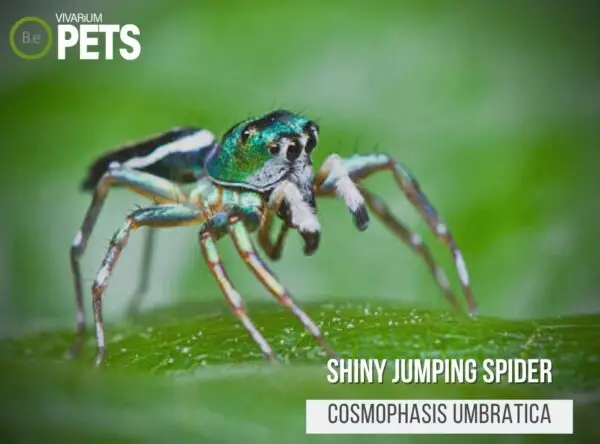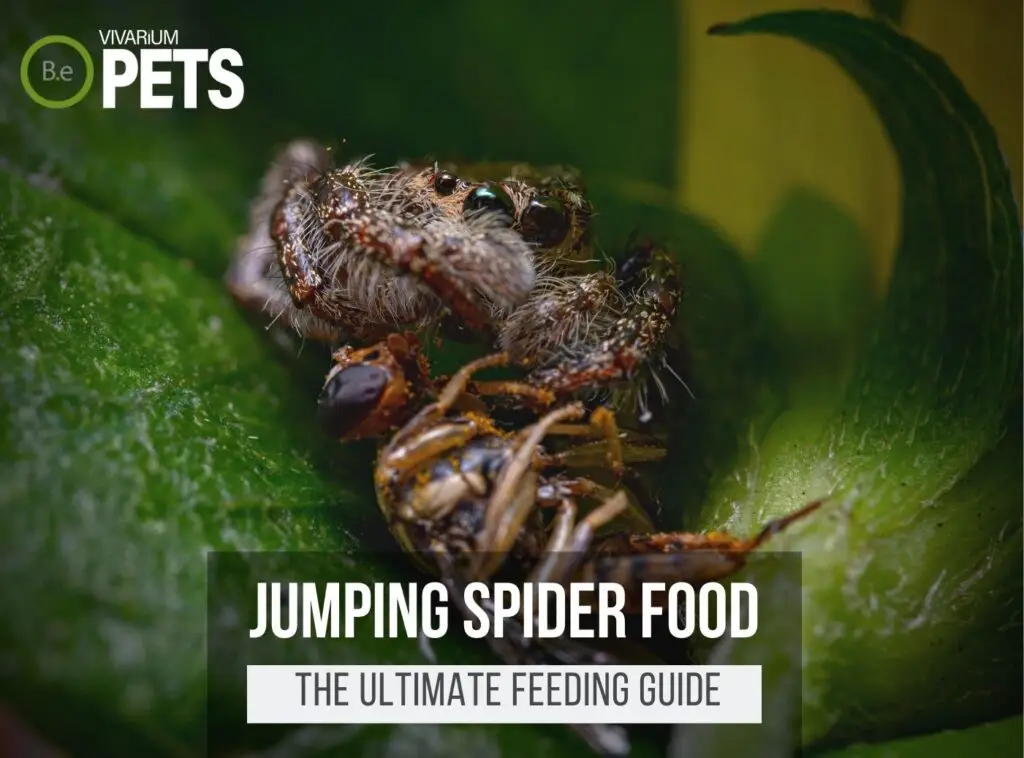If you’re even a slight arachnophile, seeing a Shiny Jumping Spider will induce a classic case of shiny object syndrome!
These metallic jumpers are remarkable in every way and if you’ve leaped owning one, I want to help you.
Whether you’re an experienced arachnid keeper or new to the world of spiders, this Cosmophasis umbratica care guide can provide you with the information you need to ensure that you and your spider have the best care experience possible.
Read on to learn all the tips and tricks for successfully caring for this kind of pet jumping spider!
Table Of Contents:
ToggleWhat Are Shiny Jumping Spiders?
Cosmophasis umbratica, commonly known as the Shiny Jumping Spider, is an eight-legged arachnid belonging to the family Salticidae.
Shiny Jumpers are colorful, eye-catching spiders that can be found in several parts of the world, including Africa and Asia.
This species of Salticidae earned its common name from its colorful and glossy exterior, giving it a “shiny” appearance.
Create the perfect home for your arachnid with our Customizable Spider Enclosure Kits, designed to meet all their habitat needs.
What Do Shiny Jumping Spiders Look Like?
Shiny Jumpers are small, brightly colored spiders that are native to parts of South Asia.
They usually measure between 5-7 mm in length, and they have a relatively flat body shape.
Cosmophasis umbratica come in dazzling colors, ranging from silvery blue to bright orange.
Their eight eyes are their most distinguishing feature, arranged in two distinct rows.
Their fur is usually mildly fuzzy and they have two long and slender appendages at the rear of their body.
Shiny Jumping Spiders don’t build webs but rather lurk on plants and foliage, and use their acute eyesight to hunt down their prey.
Benefits Of Using Shiny Jumping Spiders
Cosmophasis umbratica makes excellent additions to many types of vivariums and can be enjoyed by those of all ages.
For those keeping other small animals such as amphibians, birds, reptiles, or other arachnids in their enclosure, they may appreciate the additional interest and activity Shiny Jumping Spiders bring.
Furthermore, these spiders can help keep pest populations under control by preying on other small insects, such as moth larvae, in large tanks.
They are known for their bright coloration and interesting behaviors, but may also be enjoyed for their beneficial traits as well.
Lastly, Shiny Jumpers are low maintenance and can survive on a simple diet of insects, so they don’t require significant daily care.

Shiny Jumping Spider Facts
Cosmophasis umbratica are typically found in tropical climates, are a few millimeters long, and usually live up to a few years.
They feed on typical spider prey such as small insects and mites, and they have a generally docile temperament.
Breeding occurs during the spring and summer months, after which a female Shiny Jumping Spider will lay batches of eggs and produce 1-2 generations each year.
Habitat
Shiny Jumping Spiders are native to South and Southeast Asia, where they are found living in dry, rocky areas between crevices and under stones and logs.
Although they are primarily inner terrestrial, they will climb onto rocks and trees when looking for more food and water.
By controlling the insect population, they play an important role in the ecosystem.
Cosmophasis umbratica are solitary creatures and will rarely interact with other spiders of their kind, instead preferring to live in an isolated burrow or nest they create underground.
Replicate their natural habitat perfectly with our bioactive species-specific soil mixes, designed to provide the ideal moisture and organic content for your arachnids.
Diet
Shiny Jumping Spiders in their natural habitat feed primarily on small insects, such as ants, flies, and moths.
Due to their relatively small size, these spiders need to be able to move quickly.
As such, they are mostly ambush predators, hiding in wait for their prey to cross their path.
However, they will also scavenge food when necessary.
Shiny Jumping Spiders will also drink water, so it’s important to provide them with a small bowl that can be kept full and clean.
Temperament
Cosmophasis umbratica is generally non-aggressive and non-venomous to humans. They are also not known to bite.
However, they can get somewhat skittish around movement and may jump away if disturbed, so it is a good idea to handle them with care.
It’s also important to keep them away from other animals, as their instinct is to hunt and they may try to hunt other creatures in their habitat.
Lifespan
Shiny Jumping Spiders have an average lifespan of 1-3 years, however, in the right environment and with proper care, they can live for longer.
Unmaintained and overall poor environmental conditions, such as an overcrowded cage, are known to shorten their lifespan.
The life cycle of Shiny Jumping Spiders includes multiple stages: egg, spiderling, and adult.
The spiders start their life within an egg sac laid by the female parent.
From eggs, they will hatch into spiderlings, which molt and feed several times, until they reach the pupal stage.
After they enter adult life, they feed upon other invertebrates or insects.
In general, Shiny Jumping Spiders will reach adulthood a few months after hatching.
Breeding
Mating and reproduction in Shiny Jumping Spiders are quite different than in other spider species.
They do not produce webs to catch prey but instead, males possess a special pheromone that they use to attract females.
When the female is interested, she will allow the male to approach and the two will mate.
After the mating process is complete, the female will lay her eggs in a thin silk sac.
This will protect the eggs until they hatch and the spiderlings emerge.
Depending on the species, Cosmophasis umbratica can lay anywhere from a handful to dozens of eggs.
Additionally, the female will generally stay with her egg sac until the spiderlings emerge.
This increases their chance of surviving in the wild.
Where To Find Shiny Jumping Spiders
Cosmophasis umbratica are found in tropical rainforest habitats and countries such as Malaysia, Indonesia, Thailand, Singapore, and Vietnam.
If you’re looking to buy a Shiny Jumping Spider, the best option is to contact a reputable breeder in your area.
They will be able to provide you with valuable information about the species and the condition of the animal before you buy it.
It’s important to remember that being inexperienced or unaware of what to look for when inspecting these spiders can easily put your spider in danger, so it’s always best to purchase one from a professional.
Additionally, online sources such as pet stores and classified ads are also great places to search for Shiny Jumpers, so be sure to review these as well.
Shiny Jumping Spider Care
Caring for Shiny Jumping Spiders requires housing them in an adequately sized enclosure, providing them with a steady supply of food and water, cleaning and maintaining their habitat regularly, and handling them carefully.
Additionally, be sure to look out for signs of stress or illness to ensure Cosmophasis umbratica is healthy.
Tank Requirements
Shiny Jumping Spiders require an environment that closely mimics what they would experience in the wild.
Ideal set-ups include glass tanks with air holes and a secure lid, terrariums, and critter cages that are between 5 and 10 gallons in size.
The ideal pH for water given is 6-7.5, with appropriate hardness levels of 5-10 dKH.
These spiders prefer slightly warmer temperatures ranging from 75-85°F, with 80-82°F being the most comfortable range.
Terrarium substrate aids in humidity regulation, so it is advised to use peat moss, coconut fiber, or a mix of the two.
As they are arboreal spiders, they prefer a variety of high perches and places to hide.
A general rule of thumb is to make sure the height of the tank is 3-4 times greater than the length.
The tank should also be furnished with a low-wattage terrarium light for 8-12 hours a day to provide heat and light.
What Do Shiny Jumping Spiders Eat?
Feeding Cosmophasis umbratica can be simple, but it is vital to provide them with a balanced and diverse diet.
The best way to do this is to give them a variety of small food sources, including insects such as crickets, flies, beetles, and moths.
You can also offer your spider small pieces of fruit and vegetables, including bananas, apples, cucumbers, and carrots.
Additionally, you can supplement their diet with high-quality gut-loading cricket feed which should be available from your pet store.
Lastly, Shiny Jumping Spiders can benefit from regular gut-loading with a variety of nutrients such as calcium, phosphorus, and magnesium.
If you’re looking for a more detailed approach to feeding these critters, be sure to check out my ultimate DIY jumping spider food guide. I give a more in-depth explanation of the best foods and my favorite recipe.
Best Tankmates For Shiny Jumping Spiders
For those of you considering adding tankmates to care for your Shiny Jumping Spider, the best options are other small critters.
Small invertebrates like isopods and millipedes may make good tankmates for Cosmophasis umbratica.
Isopods are popularly used as part of a complete habitat clean-up crew for their ability to keep the substrate clean by consuming detritus.
Millipedes are also beneficial for substrate maintenance, but they can also help in keeping humidity levels high.
As long as these tankmates are well-fed, there should be no issues when sharing a habitat with a Shiny Jumper.
Conclusion
Providing the appropriate care and environment for Cosmophasis umbratica not only keeps them healthy and thriving but also allows you to form a closer bond with this special animal.
By understanding the needs of your spider and following the tips outlined in this guide, you can be sure that you both will have a positive experience as you explore the exciting world of spiders together!
Create the ideal habitat for your arachnids with our species-specific soil mixes and Spider Enclosure Kits. These products provide everything you need for a thriving spider habitat.
Frequently Asked Questions
Most shiny jumping spiders are typically 5–7 mm in size.
The shiny jumping spider is a species of jumping spider that has a glossy body.







